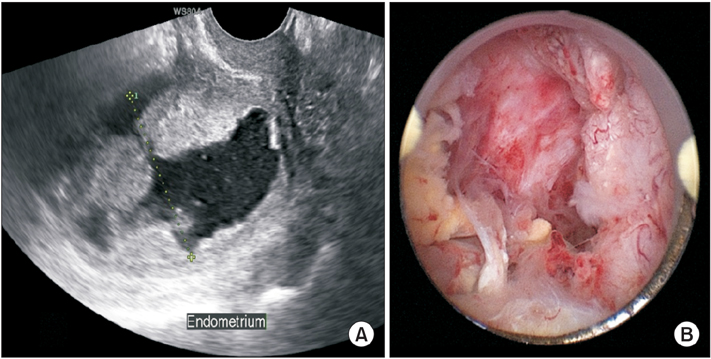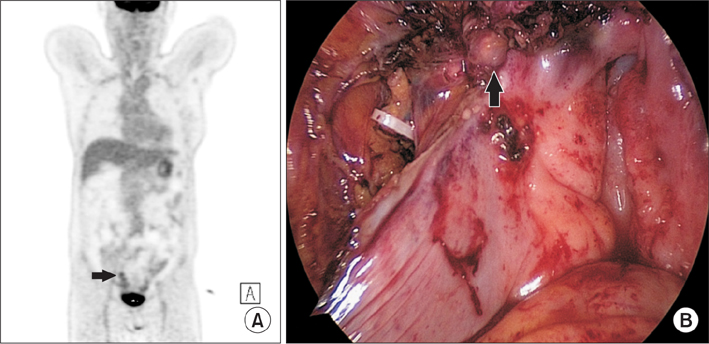J Menopausal Med.
2016 Aug;22(2):122-125. 10.6118/jmm.2016.22.2.122.
Uterine Clear Cell Carcinoma of Postmenopausal Woman: A Case Report
- Affiliations
-
- 1Department of Obstetrics and Gynecology, Soonchunhyang University College of Medicine, Bucheon, Korea.
- 2Department of Obstetrics and Gynecology, Dong-A University College of Medicine, Busan, Korea. mdpjw1216@gmail.com
- KMID: 2365469
- DOI: http://doi.org/10.6118/jmm.2016.22.2.122
Abstract
- Endometrial cancer is the most common gynecologic malignancy in developed countries. Clear cell carcinoma typically occurs in the ovaries, and very rarely occurs in the endometrium; it accounts for less than 3% of all endometrial cancers. It is presumed that clear cell carcinomas are of Müllerian duct origin, and an association with exposure to diethylstilbestrol (DES) or other nonsteroidal follicle stimulating hormones has been described. We report a case of a postmenopausal woman who presented with vaginal bleeding without a specific medical history. Under the impression of an endometrial mass, we performed a laparoscopic operation. Pathologic results showed clear cell carcinoma of the endometrium. Depth of invasion was 0.2 cm out of a 0.5 cm total thickness, and the rectal shelf mass was clear cell carcinoma. We report the case with a brief review of the relevant literature.
MeSH Terms
Figure
Reference
-
1. Lim MC, Moon EK, Shin A, Jung KW, Won YJ, Seo SS, et al. Incidence of cervical, endometrial, and ovarian cancer in Korea, 1999-2010. J Gynecol Oncol. 2013; 24:298–302.2. Hamilton CA, Cheung MK, Osann K, Chen L, Teng NN, Longacre TA, et al. Uterine papillary serous and clear cell carcinomas predict for poorer survival compared to grade 3 endometrioid corpus cancers. Br J Cancer. 2006; 94:642–646.3. Silverberg SG, De Giorgi LS. Clear cell carcinoma of the endometrium. Clinical, pathologic, and ultrastructural findings. Cancer. 1973; 31:1127–1140.4. Herbst AL, Scully RE. Adenocarcinoma of the vagina in adolescence. A report of 7 cases including 6 clear-cell carcinomas (so-called mesonephromas). Cancer. 1970; 25:745–757.5. Parkin DM, Bray F, Ferlay J, Pisani P. Global cancer statistics, 2002. CA Cancer J Clin. 2005; 55:74–108.6. Photopulos GJ, Carney CN, Edelman DA, Hughes RR, Fowler WC Jr, Walton LA. Clear cell carcinoma of the endometrium. Cancer. 1979; 43:1448–1456.7. Park JW, Hwang SO. Abdominal wall metastasis of uterine papillary serous carcinoma in a post-menopausal woman: a case report. J Menopausal Med. 2014; 20:35–38.8. Heo EJ, Park JM, Lee EH, Lee HW, Kim MK. A case of perimenopausal endometrial cancer in a woman with MSH2 germline mutation. J Menopausal Med. 2013; 19:143–146.9. Reich O, Pürstner P, Klaritsch P, Haas J, Lahousen M, Tamussino K, et al. Prognostic significance of preoperative DNA flow cytometry in surgically-treated cervical cancer. Eur J Gynaecol Oncol. 2003; 24:13–17.10. Christopherson WM, Alberhasky RC, Connelly PJ. Carcinoma of the endometrium: I. A clinicopathologic study of clear-cell carcinoma and secretory carcinoma. Cancer. 1982; 49:1511–1523.11. Bae HS, Kim H, Young Kwon S, Kim KR, Song JY, Kim I. Should endometrial clear cell carcinoma be classified as Type II endometrial carcinoma? Int J Gynecol Pathol. 2015; 34:74–84.
- Full Text Links
- Actions
-
Cited
- CITED
-
- Close
- Share
- Similar articles
-
- A Case of Clear Cell Basal Cell Carcinoma
- Hematometra Due to Cervical Stenosis in a Postmenopausal Woman with Incidental Ovarian Steroid Cell Tumor: A Case Report
- Clear Cell Carcinoma Presented as a Large Polypoid Mass Expanding the Vaginal Fornix: Report of Two Cases
- A case of clear cell carcinoma of uterine cervix not related to intrauterine dietylstilbesterol exposure
- A case of clear cell carcinoma that is unrelated to diethystilbestrol of the uterine cervix



